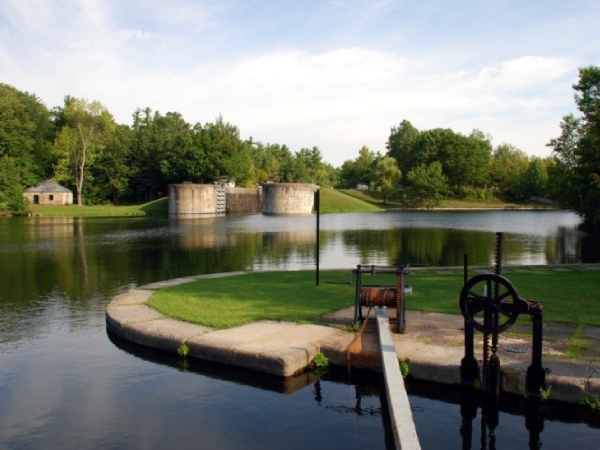Rideau Canal National Historic Site
The Rideau Canal was designated as a national historic site in 1925.
Commemorative plaque: by the canal, under the Plaza Bridge, Ottawa, OntarioFootnote 1
The Rideau Canal
Built between 1826 and 1832, the Rideau Canal is the best-preserved, fully operational example from North America’s great canal-building era. Lieutenant-Colonel John By’s innovative design was based on a “slackwater” system that linked lakes and rivers on a scale unprecedented in North America. The result was one of the first canals in the world engineered for steam-powered vessels. Its construction through more than 200 kilometres of bush, swamps, and lakes was a monumental feat. Each year, as many as 5,000 workers, mainly Irish immigrants and French Canadians, toiled under the supervision of civil contractors and Royal Engineers. Working in extremely difficult conditions, they endured injury and disease, and hundreds died. This fortified waterway was intended as a safe military supply route between Montréal and Lake Ontario by providing an alternative to the St. Lawrence River. It chiefly served as a key artery for moving goods and people until the 1850s and became a popular recreational destination in the 20th century. The Rideau Canal was inscribed on UNESCO’s World Heritage List in 2007.

© Parks Canada / M. Trépanier

© Parks Canada / Shana Quesnel
Description of historic place
Rideau Canal National Historic Site of Canada is a 200 km man-made waterway running through a corridor of communities from Ottawa River to Lake Ontario. It was built in the mid 19th century. The designation includes lands alongside the canal which are administered by Parks Canada.
Heritage value
Rideau Canal was designated a national historic site of Canada in 1925. It is designated because:
- built between 1826 and 1832, it is the best preserved canal from the great canal-building era in North America that is still fully operational: its historic structures and environment speak to its ingenious design, construction, and military purpose, as well as to its social and economic functions;
- it exemplifies cutting edge canal design due to Lieutenant-Colonel John By’s innovative “slackwater” approach, which created a navigable route from natural waterways and lakes on a scale previously unseen in North America, and because it was one of the first canals in the world engineered specifically for steam-powered vessels;
- its construction through more than 200 kilometers of bush, swamps, and lakes was a monumental feat. Each year, as many as 5,000-6,000 workmen assembled at over two-dozen worksites. The great majority of the labourers were Irish and French Canadian toiling under the supervision of contractors and the Royal Engineers. Working primarily with hand tools and in extremely difficult and dangerous conditions, these labourers and skilled craftsmen, such as Scottish stonemasons, endured disease and injury, with large numbers dying during the canal’s construction;
- in the aftermath of the War of 1812, when relations with the United States were tense, it was built to serve as a military canal and represented a fundamental component of Britain’s defences in the interior of North America, safeguarding the supply lines between Montréal and Lake Ontario by providing an alternative and more defensible route to that along the St. Lawrence River;
- it contributed significantly to the social and economic development of Upper Canada / Ontario prior to 1850, when it was a key artery for the movement of goods and people in and out of the colony. After that time, it continued to be of local commercial importance until the 1930s; since then it has served as a popular recreational route.

© Parks Canada / Shana Quesnel

© Parks Canada / Shana Quesnel

© Parks Canada / Shana Quesnel

© Parks Canada / Shana Quesnel
The heritage value of the Rideau Canal lies in the health and wholeness of its cultural landscape, as a witness of the early 19th-century forms, materials and technologies of the waterway, and as a dynamic reflection of the longstanding human and ecological inter-relationships between the canal and its corridor. The Rideau Canal was built for the British government by Lieutenant-Colonel John By as a defensive work in 1826-1837. Canada assumed responsibility for its management in 1855, and the waterway served as a commercial transportation route through most of the 19th and 20th centuries. Parks Canada acquired the canal to sustain its recreational operation in 1972.
Sources: Historic Sites and Monuments Board of Canada Minutes, June 1924, 1967, November 1987; Commemorative Integrity Statement, 1987.

© Parks Canada / Shana Quesnel

© Parks Canada / Shana Quesnel
The National Program of Historical Commemoration relies on the participation of Canadians in the identification of places, events and persons of national historic significance. Any member of the public can nominate a topic for consideration by the Historic Sites and Monuments Board of Canada.
Related links
- National historic designations
- National historic persons
- National historic sites designations
- National historic events
- Submit a nomination
- Lieutenant-Colonel John By National Historic Person
- Rideau Canal, UNESCO’s World Heritage Site of Canada
- The Rideau Canal was also designated as a Heritage River by the Canadian Heritage Rivers System in 2000
- This Week in History
- Date modified :
